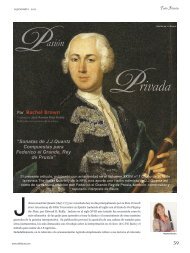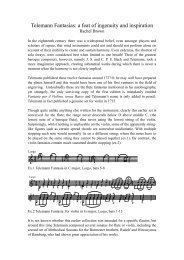Mozart's flute: magic, mediocre or maligned? - Rachel Brown
Mozart's flute: magic, mediocre or maligned? - Rachel Brown
Mozart's flute: magic, mediocre or maligned? - Rachel Brown
Create successful ePaper yourself
Turn your PDF publications into a flip-book with our unique Google optimized e-Paper software.
Given that at that time Mozart was in love, experiencing his first taste of freedom<br />
and wanting to be out socialising and that he was very frustrated, strained and<br />
defensive on account of the constant badgering from his father, it is understandable<br />
that he was not in the best frame of mind f<strong>or</strong> composing, and it is probable that his<br />
remark about the <strong>flute</strong> was made on the spur of the moment. However, Mozart may<br />
have had grounds f<strong>or</strong> not liking the <strong>flute</strong> of course. Radical changes were made to<br />
the instrument during his lifetime, but at this point, many players (Wendling and<br />
De Jean probably among them) would still have been using one-keyed <strong>flute</strong>s. Such<br />
instruments were well suited to the baroque music they were invented f<strong>or</strong> and a<br />
good <strong>flute</strong> in the hands of a skilled and flexible player with an intuitive, sensitive<br />
composer could use the brighter tonalities and upper register to sound strong and<br />
happy and the delicate colours of the flat keys to great Affekt. Whilst these colours<br />
could and should be brought to classical repertoire, much dramatic <strong>or</strong>chestral<br />
music used the flat tonalities f<strong>or</strong> powerful impact and consequently the <strong>flute</strong> is<br />
often absent in so many w<strong>or</strong>ks of the Sturm und Drang type. Classical <strong>or</strong>chestral<br />
<strong>flute</strong> parts often lie in the high register and though many one-keyed <strong>flute</strong>s ascended<br />
at least to A’’’, the high F’’’ was frequently either non-existent <strong>or</strong> barely acceptable.<br />
In a few exceptional one-keyed <strong>flute</strong>s F’’’ was a good, strong note.<br />
By the last quarter of the eighteenth century <strong>flute</strong>s with m<strong>or</strong>e keys were becoming<br />
popular, 29 though were by no means standard. These keys provided the <strong>flute</strong> with<br />
one tone hole f<strong>or</strong> every note (<strong>or</strong> most), albeit holes of uneven size and spacing on a<br />
tapering b<strong>or</strong>e, and brought a new-found degree of son<strong>or</strong>ity and evenness to the<br />
<strong>flute</strong>. The combined use of one-keyed and multi-keyed fingerings offered a wider<br />
palette of colours.<br />
However, pitch was never standardized so wind players frequently had problems<br />
adjusting to a higher <strong>or</strong> lower pitch, particularly if they travelled. Flutes were<br />
constructed with interchangeable centre-pieces (c<strong>or</strong>ps de rechange) of slightly<br />
different lengths, extendable foot registers and moveable c<strong>or</strong>ks but whilst<br />
sometimes partially successful, this method was often a po<strong>or</strong> substitute f<strong>or</strong> having a<br />
well-tuned instrument at one agreed pitch.<br />
Pri<strong>or</strong> to taking on the commission from De Jean, Mozart had actually written very<br />
little featuring the <strong>flute</strong>. The early sonatas, opus 3, f<strong>or</strong> harpsich<strong>or</strong>d with violin <strong>or</strong><br />
<strong>flute</strong> accompaniment and ad lib. cello were composed in London in 1765 (at the age<br />
of eight) and dedicated to Queen Charlotte. These six sonatas are charming but<br />
clearly not conceived primarily f<strong>or</strong> the <strong>flute</strong> since much of the violin part contains<br />
double stopping, pizzicato and notes on the G string, below the range of the <strong>flute</strong>. 30<br />
Perhaps the designation f<strong>or</strong> <strong>flute</strong> was added to the title page as a gesture to King<br />
Ge<strong>or</strong>ge III, who played the <strong>flute</strong>, <strong>or</strong> m<strong>or</strong>e likely, in <strong>or</strong>der to increase sales,<br />
particularly in England where the <strong>flute</strong> had become so popular.<br />
Most of Mozart’s ch<strong>or</strong>al w<strong>or</strong>ks, early symphonies and operas contain either nothing<br />
f<strong>or</strong> <strong>flute</strong> <strong>or</strong> else small parts, which in some cases may have been played by oboists<br />
doubling on <strong>flute</strong>. 31 If <strong>flute</strong>s are present, they rarely have independent lines but are<br />
Taken from www.rachelbrown<strong>flute</strong>.com - ©2008 – <strong>Rachel</strong> <strong>Brown</strong>




